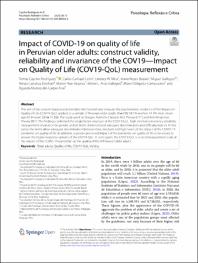| dc.contributor.author | Rosales-Rimache, Jaime | |
| dc.contributor.author | Chavez-Ruiz, Manuel | |
| dc.contributor.author | Inolopú-Cucche, Jorge | |
| dc.contributor.author | Rabanal-Sanchez, Jhonatan | |
| dc.contributor.author | Rueda-Torres, Lenin | |
| dc.contributor.author | Sanchez-Holguin, Gloria | |
| dc.date.accessioned | 2023-09-12T22:00:46Z | |
| dc.date.available | 2023-09-12T22:00:46Z | |
| dc.date.issued | 2022-05-30 | |
| dc.identifier.uri | https://hdl.handle.net/20.500.13053/9350 | |
| dc.description.abstract | “Peru is one of the countries with the highest lead
contamination in the world. Biological monitoring has limitations due to the shortage of laboratories with validated
methodologies for the measurement of blood lead, and it is
necessary to use alternative methods for its measurement in
high-altitude cities. We aimed to compare the blood lead
levels (BLL) measured by the LeadCare II (LC) method and
Graphite Furnace Atomic Absorption Spectrometry (GFAAS). We measured the BLL of 108 children from the city of
La Oroya. The mean and median BLL for GF-AAS were
10.77 ± 4.18 and 10.44 lg/dL, respectively; for the LC
method, the mean was 11.71 ± 4.28 and the median was
11.60 lg/dL. We found a positive linear correlation
(Rho = 0.923) between both methods. Notwithstanding, the
Wilcoxon test suggests a significant difference between both
methods (q = 0.000). In addition, the Bland–Altman
analysis indicates that there is a positive bias (0.94) in the LC
method, and this method tends to overestimate the BLL.
Likewise, we performed a generalized linear model to
evaluate the influence of age and hemoglobin on BLL. We
found that age and hemoglobin had a significant influence on
BLL measured by the LC method. Finally, we used two nonparametric linear regression methods (Deming and PassingBablok regression) to compare the LC method with the GFAAS. We found that these methods differ by at least a constant amount, and there would be a proportional difference
between both. Although in general there is a positive linear
correlation, the results of both methods differ significantly.
Therefore, its use in cities located at high altitudes (higher
than 2440 m.a.s.l.) would not be recommended.“ | es_PE |
| dc.format | application/pdf | es_PE |
| dc.language.iso | eng | es_PE |
| dc.publisher | Springer | es_PE |
| dc.rights | info:eu-repo/semantics/openAccess | es_PE |
| dc.rights.uri | https://creativecommons.org/licenses/by/4.0/ | es_PE |
| dc.subject | LeadCare Blood Lead Graphite Furnace Atomic Absorption Spectrometry | es_PE |
| dc.title | Leadcare II Comparison with Graphite Furnace Atomic Absorption Spectrophotometry for Blood Lead Measurement in Peruvian Highlands | es_PE |
| dc.type | info:eu-repo/semantics/article | es_PE |
| dc.identifier.doi | 10.1007/s12291-022-01050-y | |
| dc.type.version | info:eu-repo/semantics/publishedVersion | es_PE |
| dc.publisher.country | IND | es_PE |
| dc.subject.ocde | 3.03.00 -- Ciencias de la salud | es_PE |


